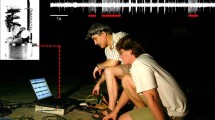Abstract
A “big picture” of sensory ecology is developed. The logic of biological investigation and the meaning of behavior and information are briefly addressed along with the importance of information to organisms. Ties between sensory ecology and physiology and behavior are stressed. The value of understanding physical constraints on what is possible is emphasized. The simplest physical environment is that of planktonic organisms living free of any surface, and consequences of physical constraints and biological generalities are described for such organisms, as examples. This provides new insights into why small bacteria are not motile, why most chemotactic bacteria are rods employing temporal mechanisms of comparison for gradient detection, why small planktonic animals do not employ pheromones for mate attraction, and explaining why male and female mating types are common among sexually reproducing species.
Access this chapter
Tax calculation will be finalised at checkout
Purchases are for personal use only
Preview
Unable to display preview. Download preview PDF.
Similar content being viewed by others
References
Baldwin IT, Schultz JC (1983) Rapid changes in tree leaf chemistry induced by damage: evidence for communication between plants. Science 221: 277–279
Ballaré CL, Scopel AL, Sanchez RA (1990) Far-red radiation reflected from adjacent leaves: an early signal of competition in plant canopies. Science 247: 329–332
Berg HC (1993) Random Walks in Biology. Princeton University Press, Princeton
Berg HC, Purcell EM (1977) Physics of chemoreception. Biophys J 20: 193–219
Bradburne JA, Kasperbauer MJ, Mathis JN (1989) Reflected far-red light effects on chlorophyll and light-harvesting chlorophyll protein ( LHC-II) contents under field conditions. Plant Physiol 91: 800–803
Dusenbery DB (1992) Sensory Ecology. WH Freeman and Company, New York
Dusenbery DB (1996) Life at Small Scale. Scientific American Library, New York
Dusenbery DB (1997) Minimum size limit for useful locomotion by freeswimming microbes. Proc Natl Acad Sci USA 94: 10949–10954
Dusenbery DB (1998a) Fitness landscapes for effects of shape on chemotaxis and other behaviors of bacteria. J Bact 180: 5978–5983
Dusenbery DB (1998b) Spatial sensing of stimulus gradients can be superior to temporal sensing for free-swimming bacteria. Biophys J 74: 2272–2277
Dusenbery DB (2000) Selection for high gamete encounter rates explains the success of male and female mating types. J Theor Biol 202: 1–10
Dusenbery DB, Snell TW (1995) A critical body size for use of pheromones in mate location. J Chem Ecol 21: 427–438
Jumars PA (1993) Concepts in Biological Oceanography. Oxford University Press, New York
Kasperbauer MJ (1987) Far-red light reflection from green leaves and effects on phytochrome-mediated assimilate partitioning under field conditions. Plant Physiol 85: 350–354
Land MF (1981) Optics and vision in invertebrates. In: Autrum H (ed) Handbook of Sensory Physiology. Springer, Berlin, pp 471–593
Lythgoe JN (1979) The Ecology of Vision. Clarendon Press, Oxford
Mangel M, Clark CW (1988) Dynamic Modeling in Behavioral Ecology. Princeton University Press, Princeton, New Jersey
Mann KH, Lazier JRN (1991) Dynamics of Marine Ecosystems. Blackwell Scientific Publications, Boston
McKechnie JL (1978) Webster’s New Twentieth Century Dictionary of the English Language. William Collins Publishers, Inc
Perrin F (1934) Mouvement Brownien d’un ellipsoide (I). Dispersion diélectrique pour des molécules ellipsoidales. Le Journal de Physique et Le Radium V 10: 497–511
Perrin F (1936) Mouvement Brownien d’un ellipsoide (II). Rotation libre et dépolarisation de fluorescence. Translation et diffusion de molécules ellipsoidales. Le Journal de Physique et Le Radium VII 1: 1–11
Rhoades DF (1985) Pheromonal communication between plants. In: Cooper-Driver GA, Swain T (eds) Chemically Mediated Interactions Between Plants and Other Organisms. Plenum Press, New York, pp 195–218
Rouse H (1961) Fluid Mechanics for Hydraulic Engineers. Dover Publications, New York
Surette MG, Miller MB, Bassler BL (1999) Quorum sensing in Escherichia coli, Salmonella typhimurium, and Vibrio harveyi: A new family of genes responsible for autoinducer production. Proc Natl Acad Sci USA 96: 1639–1644
Tanford C (1963) Physical Chemistry of Macromolecules. Wiley, New York
van Holde KE (1985) Physical Biochemistry. Prentice-Hall, Englewood Cliffs, NJ
Withers PC (1992) Comparative Animal Physiology. Saunders College Publishing, Fort Worth
Zuriff GE (1985) Behaviorism: A Conceptual Reconstruction. Columbia University Press, New York
Author information
Authors and Affiliations
Editor information
Editors and Affiliations
Rights and permissions
Copyright information
© 2001 Springer-Verlag Berlin Heidelberg
About this paper
Cite this paper
Dusenbery, D.B. (2001). Physical Constraints in Sensory Ecology. In: Barth, F.G., Schmid, A. (eds) Ecology of Sensing. Springer, Berlin, Heidelberg. https://doi.org/10.1007/978-3-662-22644-5_1
Download citation
DOI: https://doi.org/10.1007/978-3-662-22644-5_1
Publisher Name: Springer, Berlin, Heidelberg
Print ISBN: 978-3-642-08619-9
Online ISBN: 978-3-662-22644-5
eBook Packages: Springer Book Archive




